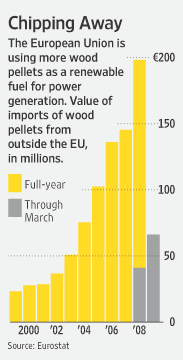Wood Pellets Catch Fire as Renewable Energy Source
-----------------
Some of the fastest growing sources of renewable energy in the world are the wind, the sun -- and the lowly wood pellet.
European utilities are snapping up the small combustible pellets to burn alongside coal in existing power plants. As a global marketplace emerges to feed their growing appetite for pellets, the Southeastern U.S. is becoming a major exporter, with pellet factories sprouting in Florida, Alabama and Arkansas.
 |
Wood pellets -- cylinders of dried shredded wood that resemble large vitamins -- are the least expensive way to meet European renewable-energy mandates, utility executives and industry consultants say.
Made from fast-growing trees or sawdust, pellets are a pricier fuel than coal, but burning them is a less-expensive way to generate electricity than using windmills or solar panels. Burning pellets releases the carbon that the trees would emit anyway when they die and decompose, so the process is widely regarded as largely carbon neutral. In contrast, carbon is locked away in coal and is only released once the coal is dug out of the earth and burned.
The wood-pellet market is booming because the European Union has rules requiring member countries to generate 20% of their electricity from renewable sources by 2020. Europe imported €66.2 million (about $92.6 million) of pellets and other wood-based fuels in the first three months of 2009, up 62% from the same period a year earlier, according to the EU's statistical arm.
Government mandates are essential to the increasing use of pellets in power generation, and the growing global pellet trade, experts say.
"You are looking at a totally artificial market," said Christian Rakos, chief executive of Propellets, an Austria-based trade group of pellet producers. "No power plant would consider using pellets for one minute if they didn't have to do it."
Still, Europe's eagerness for more pellets has turned the U.S. into an energy exporter. Until recently, there were only about 40 pellet factories in the U.S., which produced about 900,000 tons a year, mostly for heating homes.
But in May 2008, Green Circle Bio Energy Inc. opened a pellet plant in Cottondale, Fla., that produces 500,000 tons of pellets a year; it ships them by rail to the coast and then on to Rotterdam, Netherlands. The company, owned by Swedish concern JCE Group AB, wants to build another big plant in the U.S., said Olaf Roed, chief executive of Green Circle.
Another 500,000-ton facility in Selma, Ala., owned by Dixie Pellet LLC, also opened last year. And Phoenix Renewable Energy LLC plans to break ground next month on a 250,000-ton-a-year pellet plant in Camden, Ark., along with a 20-megawatt power plant run off tree scraps that will feed heat to the pellet plant. The $100 million facility's output for five years has been contracted to go to Europe, and Phoenix is working on another five facilities.
Pellets can either be made out of sawdust left over from lumber production or from soft-wood trees such as pine. These aren't growing in wild forests, but in industrial plantations where they can be harvested easily and often.
At Green Circle's Florida facility, bark is stripped off the tree and burned to generate steam used in making the pellets. The tree itself is cut up in a wood chipper, dried and hammered into a powder, which is formed into pellets under very high pressure.
It is easy for these pellet plants to find raw material. The pulp and paper industry is declining, and the housing slump has sapped the need for hardwood. Forest owners are ecstatic that pellet plants are stepping in.
"We are irrationally exuberant," said Lee Laechelt, executive vice president of the Alabama Forest Owners Association.
Australia, New Zealand, Argentina and Vietnam are also shipping pellets to Europe, as are Canada and South Africa, said Helmer Schukken, CEO of GF Energy BV, a Rotterdam-based trader.
Wood pellets are becoming the newest global commodity, with prices posted on an Amsterdam energy exchange, Mr. Schukken said. "It is becoming like trading coal."
That will make it easier for England's Drax Group PLC, which is installing equipment at its giant 4,000-megawatt coal-fired power plant in North Yorkshire to use pellets in place of coal for up to 10% of the fuel. Pellet makers say Drax is lining up contracts in the U.S. Other big buyers include Dutch power company Essent NV, which is being acquired by Germany's RWE AG, and French GDF Suez SA's Electrabel unit.
Of course, U.S. utilities may soon be as interested as their European counterparts in burning pellets instead of coal. California, which has a goal of producing 33% of its electricity from renewable sources by 2020, is looking at using wood products in coal plants.
If a federal renewable energy standard is approved, "we won't be shipping pellets overseas," said Phoenix Renewable Energy's development director, Steve Walker. "We'll be shipping them domestically."
Copyright:Issued by: The Wall Street Journal
Author: Russell Gold
e-Mail: russell.gold@wsj.com
Issue date: July 7, 2009
Link to Article: Origin of text
---------------

